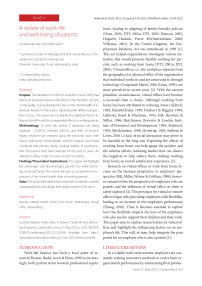A review of work-life and well-being of parents
Автор: Mandal S., Sinha V.
Журнал: Cardiometry @cardiometry
Рубрика: Review
Статья в выпуске: 22, 2022 года.
Бесплатный доступ
Purpose: The transition from office to work-from-home (WFH) has lead to an increased interest in the effects of this transition, not only on the quality of work obtained but also on the mental health of individuals. Research in this topic is expanding with different perspectives in focus. This review aims to identify the significant factors influenced by WFH and the consequential effects on working parents. Methodology: To write this review, 4 databases are being explored - SCOPUS, Emerald, EBSCO, and Web of Science. Papers reviewed are selected using the keywords work from home, well-being, mental health, work-life balance, and family combined with parents, family, working mother, or working father. The papers have been selected for the past 25 years. An attempt is being made to review at least 53 articles. Findings/Theoretical Implications: This paper will highlight the advantages and disadvantages parents face while balancing work and family. The review will give a comprehensive impression of the mental health state of working parents. Value: The study will enable future researchers to identify currently unexplored issues and design their studies based on the same.
Parents, mental health, work from home, well-being, virtual office, teleworking
Короткий адрес: https://sciup.org/148324596
IDR: 148324596 | DOI: 10.18137/cardiometry.2022.22.203206
Список литературы A review of work-life and well-being of parents
- S. B. Ahrentzen, “Home as a workplace in the lives of women.” In-Place Attachment, pp. 113-138, (1992) Springer, Boston, MA.
- M. Aldrich, “Videotex: key to the wired city.” Hutchinson, (1982).
- S. Anderson, “The work at home balancing act:” The professional resource guide for managing yourself, your work, and your family at home. Avon Books. (1998)
- C. Bryson, T. Budd, J. Lewis and G. Elam, “Women’s attitudes to combining paid work and family life.” Cabinet Office Women’s Unit, (1999)
- M. Bulos and W. Chaker, “Sustaining a sense of home and personal identity.” The Home: Words, Interpretations, Meanings and Environments, pp. 227-239, (1995)
- L. U. Callentine, “The ecology of the mobile workplace: Influence of household composition and home workspace on satisfaction, stress, and effectiveness.” Unpublished Master’s Thesis, Cornell University, Ithaca, New York, (1995).
- S. Craipeau and J. C. Marot, “Telework: impact on living and working conditions.” European Foundation for the Improvement of Living and Working Conditions, (1983)
- T. Crosbie and J. Moore, “Work-life balance and working from home.” Social Policy and Society, vol. 3, no. 3, p. 223, (2004)
- H. Dean, “Business versus families: whose side is New Labor on?.” Social Policy and Society, vol. 1, no. 1, pp. 3-10, (2002)
- Department of Trade and Industry (DTI). (2001a). The essential guide to working “life balance”, Department of Trade and Industry, Crown Copyright. http://www.dti.gov.uk
- Department of Trade and Industry (DTI). (2002). ‘What is work-life balance?’ http://www.dti.gov.uk/work-lifebalance/what.html
- S. Duncan, “Policy discourses on ‘reconciling work and life in the EU.” Social Policy and Society, vol. 1, no. 4, pp. 305-314, (2002)
- A. J. Durbin, “Comparison of the job satisfaction and productivity of telecommuters versus in-house employees: A research note on work in progress.” Psychological Reports, vol. 68 (3_suppl), pp. 1223-1234, (1991).
- L. Duxbury and C. Higgins, “Between work and family: is telework part of the problem.” The Virtual Workplace, vol. 218, (1998).
- E. Galinsky and J. T. Bond, “The business work-life study, 1998: A Sourcebook.” Families and Work Institute, 330 Seventh Avenue, New York, NY 10001, (1998).
- E. Galinsky, J. T. Bond and D. E. Friedman, “The changing workforce: Highlights of the national study.” Diane Publishing, (1993).
- K. Gerson and J. A. Jacobs, “Who are the Overworked Americans?.” In Working Time: International Trends, Theory, and Policy Perspectives. Routledge, (1998).
- C. Gooding, “FT IT Review of information technology (59): Ten pointers for home office workers-To be an effective tele worker,” Practical Considerations Go Far Beyond the Purchase of A Personal Computer/ Getting Started-A Teleworker’s Check-List, (1995).
- (1516). Financial Times, April, 5.
- G. E. Gordon and M. M. Kelly, “Telecommuting: how to make it work for you and your company.” Englewood Cliffs, NJ: Prentice-Hall, (1986),
- P. Gurstein, “Working at home and living at home: Emerging scenarios.” Journal of Architectural and Planning Research, pp. 164-180, (1991).


